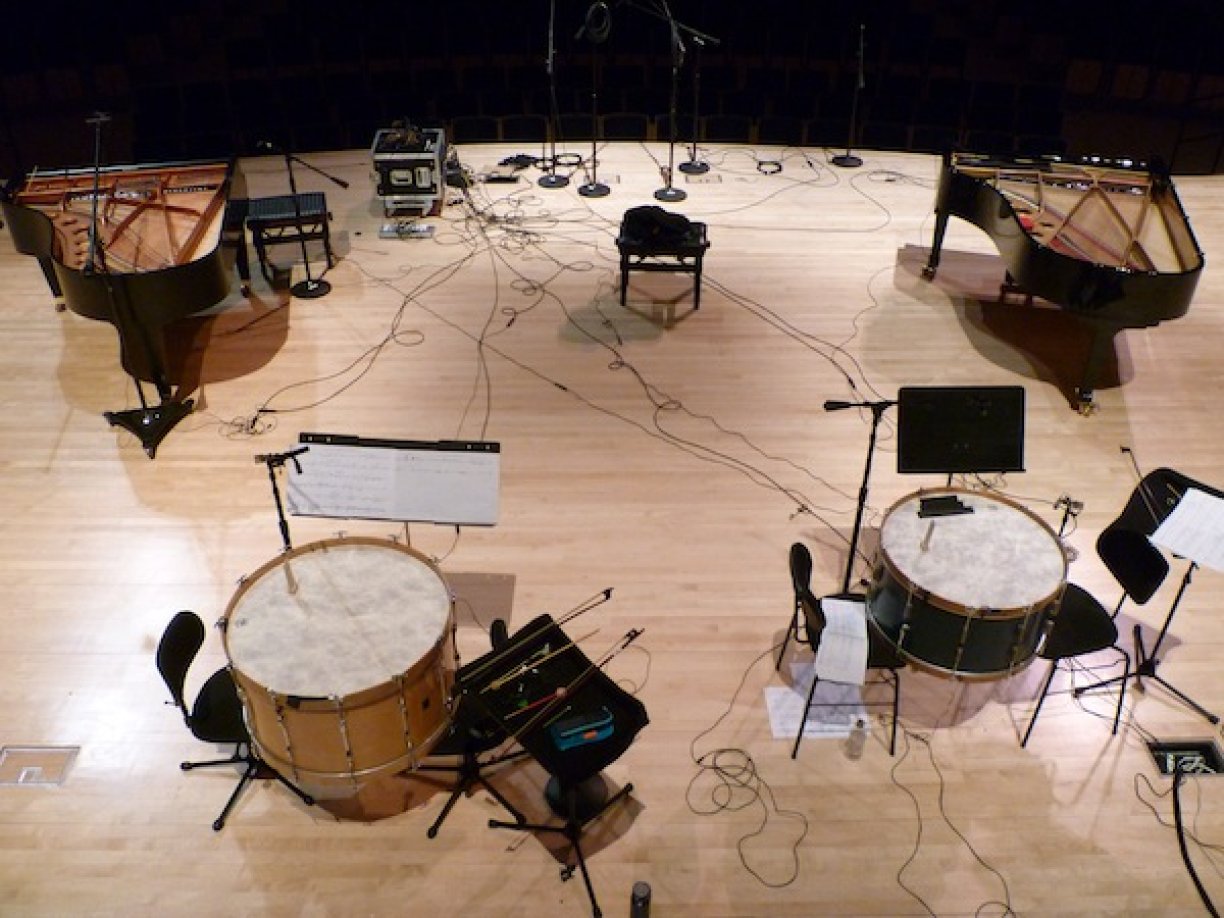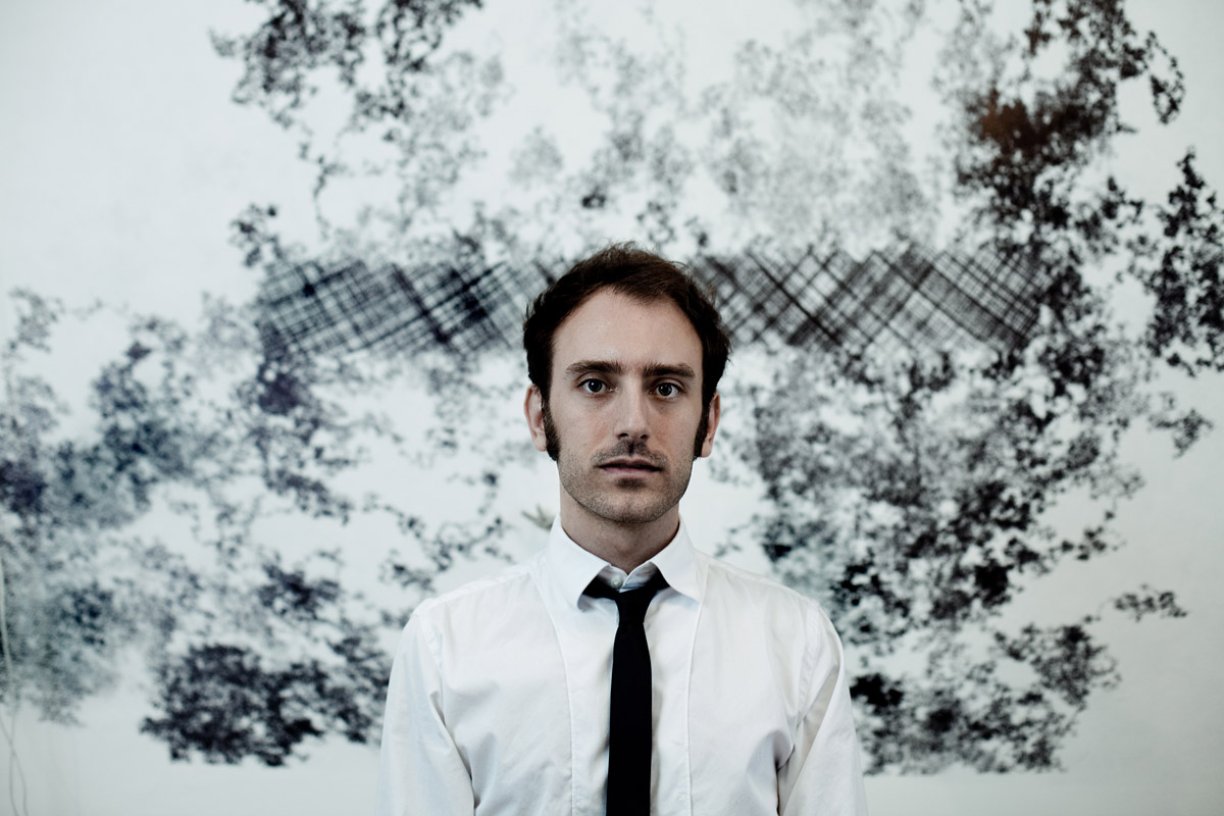For the first concert of their residency at ISSUE Project Room, Yarn/Wire has collaborated on two new pieces: one by percussionist and composer Nathan Davis and another by electronic artist Pete Swanson, best known for his work with Yellow Swans. Here, Yarn/Wire percussionist Ian Antonio speaks with ISSUE curator Lawrence Kumpf about their new projects, plans for their residency, and the ensemble’s influences.
Lawrence Kumpf: Can you start out by telling me a little about the formation of Yarn/Wire, the group’s choice of instrumentation, and performance history?
Ian Antonio: Yarn/Wire formed somewhat organically around 2005 or 2006. We were all students in the graduate program at Stony Brook University which has a pretty strong focus on contemporary classical music, especially in the percussion and piano departments. We always ended up playing in the same ensembles and just really enjoyed playing together so we decided to play a concert of our own. The first show we did in NYC belongs in the annals of awesome but insane programming. It was Berio’s Linea, Donatoni’s Cloches III, Leroux’s M, and Jarrell’s Assonance VIIb. The logistics were crazy – so many notes, so much gear, so much amplification and live electronics. If an institution like IRCAM did that program, they would literally roll up with an 18-wheeler and a crew of 10! We still do shows that utilize vast amounts of gear and electronics but we’ve learned to think all the details through before making a program.
Instrumentation really provides the core identity of Yarn/Wire. We’re not a flexible mixed chamber ensemble, our instruments are bulky and often numerous, and there’s a relatively small pool of pre-existing repertoire to choose our programming from. That said, these perceived limitations are really blessings in disguise. The four of us play together all the time which I think leads to much more intimate and subtle musical communication. Because two of us are percussionists, we have at our disposal an enormous range of sonic possibilities. And perhaps most importantly, we’ve been forced to commission and collaborate with a lot of incredible composers on the creation of our repertoire. Most of what we play is music that was commissioned by or written for us.
Over the past 5 years, we’ve had a lot of practice and become really good at presenting chamber music concerts. What I mean by that is the production of single-evening events that feature a collection of composed pieces that work well in a pre-decided order and may or may not be thematically connected. We all love those types of events, but for our year in residence at ISSUE Project Room, we’re interested in experimenting with a slightly different model. The first show will consist of two collaborative works with “double threats” Nathan Davis and Pete Swanson. Nathan is ICE’s amazing percussionist but spends an equal amount of time composing with an incredible ear for detail and intricacy. Pete Swanson performed for many years as half of Yellow Swans and generates richly layered and expansive sonic masses. We’ll be working with both of them individually to create two epic pieces, and they’ll be joining us for the performance.
LK: l’m most familiar with your compositions by younger composers such as Eric Wubbels, Alex Mincek, Aaron Einbond, and Sam Pluta so Nathan Davis of ICE seems like a natural candidate for collaboration. Although you have strong connections with the experimental rock/improv scene through Zs, Pete Swanson still seemed like a bit of a surprise to me for a Yarn/Wire collaborator. Can you talk a little bit about your collaborative process with these two artists, and how the pieces are developed, notated and performed?
IA: Well, the collaborations are still in process, but so far the works are being constructed from different angles but in similarly organic ways. Nathan is a percussionist like Russell and me, so there’s already a lot of shared vocabulary. The fact that we’ve all played together in various circumstances makes the whole process even more natural. Nathan knows what our strengths are and is able to tailor his writing to them. Pete’s process is different than Nathan’s but there are many shared concerns – what kinds of sounds does Yarn/Wire’s percussive instrumentation lend itself too, what sonic material will work well in the performance space, what is the level of interaction between “composer” and “ensemble”? You are right in noting a difference in process, though. If I could make an analogy, I would say that Nathan’s approach is that of a painter and Pete’s is that of a sculptor. Pete is starting with a huge chunk of marble and we’re collaboratively finding the shape within. He’s generating lots of sonic material with synths, tape loops, etc., and we’re then “translating” it to our instruments. Nathan is starting with a blank canvas and adding one brush stroke at a time, each detail adding to the former.
LK: I think the painting/sculpture analogy as a metaphor for thinking about traditional forms of musical notation and composing with electronics – in terms of additive and subtractive process – is very apt. Electronic music is not only produced through the subtractive process of filtering, directing and shaping of currents but also has the potential to create highly distinct sound objects and bodies through amplification and through relationally scaling sounds. The last piece I saw Yarn/Wire perform was Lucier’s Memory Space, which is an improvised piece using the amplification of the room as a score. This seems to have a lot in common with the collaborative practice you’re describing. Can you speak a little more about Yarn/Wire’s relationship to electronic music and the role in your practice?
IA: Yarn/Wire’s relationship with electronics and technology goes back to the roots of the ensemble. That first crazy concert I mentioned had two pieces that featured electro-acoustic elements, Leroux’s M, and Jarrell’s Assonance VIIb. Both were amplified and had our acoustic signal running into MAX/MSP and some virtual synths that were heroically constructed by Russell to recreate some now-obsolete hardware modules. Since then, we’ve consistently included technological components in our programming. Some notable examples would be the computer-controlled robotic/acoustic instruments in David Bithell’s Whistle From Above, Roland SPD-S triggered 3D video in Dan Iglesia’s Cardinality Aleph Two, and Aaron Einbond’s virtual acoustic models in Passagework. The level of interactivity will perhaps reach a new level in our first ISSUE Project Room concert though, as we’ll have an actual human in Pete controlling his array of gear live.
LK: Yarn/Wire has also been working with the experimental theatre group Two-Headed Calf on Trifles and You, My Mother. Can you speak a little about this collaboration and if you have any plans for future ventures of this sort.
IA: Working with Two-Headed Calf is always great and getting You, My Mother off the ground has been a huge and satisfying project. Yarn/Wire’s involvement with Two-Headed Calf has kind of trickled in over the years. I worked with them on Major Barbara in 2006, then Russell jumped on board with me for Drums of the Waves of Horikawa in 2007. That show was a lot of work over a long period of time but was just a ton of fun and really artistically satisfying. The whole group supplied music for Trifles in 2010 and then this year, our involvement is even a bit more intense because You, My Mother is a set of two chamber operas. Who knows what Two-Headed Calf will be up to next, but I for one would really love to mount a full run of their adaptation of Macbeth, It Cannot Be Called Our Mother But Our Graves. We did a few short performances of excerpts of this but never did the full version at one time, and man, it would be awesome to do the whole thing. The reason I personally keep coming back to this collaboration is because Brooke and Brendan (Two-Headed Calf’s director/composer leaders) are dedicated to producing excellent and well considered work. There’s just no substitute for that.
LK: So what do you guys have planned for the next AIR performance?
IA: Next up for us on April 28th is a new large work by Tristan Perich. It’s going to be for two grand pianos and percussion. We love Tristan’s music and we’re especially psyched he’s creating a piece for us.


